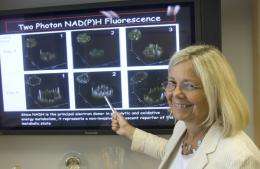New metabolic safeguards against tumor cells revealed

(PhysOrg.com) -- Cells don't like to be alone. In the early stages of tumor formation, a cell might be pushed out of its normal home environment due to excessive growth. But a cell normally responds to this homeless state by dismantling its nucleus, packing up its DNA, and offering itself to be eaten by immune system cells. Simply put, the homeless cell kills itself. This process, known as apoptosis, typically stops potential cancer cells before they have a chance to proliferate.
Now, researchers from the lab of Harvard Medical School professor of cell biology Joan Brugge have uncovered another mechanism that kills these precancerous, homeless cells. By studying two different types of human breast epithelial cells, the researchers found that when separated from their natural environment, these cells lose their ability to harvest energy from their surroundings. Eventually, they starve.
"We originally thought that in order for cells to survive outside their normal environment, they would simply need to suppress apoptosis," says Brugge, senior author on the paper, which will appear August 19 online in Nature. "But our studies indicate that this activity is not sufficient to prevent the demise of homeless cells. Even if they escape apoptosis, these cells can't transport enough glucose to sustain an energy supply."
Surprisingly, metabolic function is restored if antioxidant activity is increased inside the cells, allowing the cells to use energy pathways that don't rely on glucose.
"It raises the interesting idea that antioxidants, which are typically thought to be protective because they prevent genomic damage, might be allowing these potentially dangerous cells to survive," says first author Zachary Schafer, assistant professor at the University of Notre Dame and a former postdoc in Professor Brugge's lab.
The authors caution against extrapolating too far from their data, which were based on experiments in laboratory cell culture. They also emphasize that the experiments were not designed to mimic the effect of dietary antioxidants in the body. The researchers used two specific antioxidant compounds—which are chemically distinct from those found in food and supplements—only in order to understand how oxidants contributed to the metabolic defects.
"We think that genes with antioxidant activity play a much bigger role than antioxidant compounds administered from outside the body," says Brugge. "What happens with dietary antioxidants is much more complicated and not what we were trying to study."
Beyond cell suicide
The researchers had previously reported that when cells were endowed with a cancer-causing gene that prevents them from committing suicide, they still died when cut off from their extracellular environment. This puzzled researchers, who have long thought that apoptosis was the only way the cells could die.
In the recent study, Schafer and colleagues took a closer look, measuring the levels of proteins and molecules associated with metabolic activity in the displaced, but apoptosis-resistant, cells. They found that the cells had become incapable of taking up glucose, their primary energy source. Under the microscope, the cells also displayed telltale signs of oxidative stress, a harmful accumulation of oxygen-derived molecules called reactive oxygen species (ROS). The end result was a halt in the production of ATP, the molecular lifeblood that transports energy in the cells. The unmoored cells were literally starving to death.
"The idea that a lack of extracellular matrix can prevent cells from accessing nutrients hasn't been shown conclusively before," says Schafer. "Loss of glucose transport, decreased ATP production, increased oxidative stress—all those things turn out to be interrelated."
To figure out what was wrong, the researchers took a straightforward approach—they tried to fix it. Schafer engineered the homeless cells to express high levels of a gene, HER2, known to be hyperactive in many breast tumors. He also treated the cells with antioxidants in an attempt to relieve oxidative stress and help the cells survive.
Both strategies worked. The cells with the breast cancer gene regained glucose transport, preventing ROS accumulation, and recovered their ATP levels. The antioxidant-treated cells also survived, but by using fatty acids instead of glucose as an energy source.
"Our results raise the possibility that antioxidant activity might allow early-stage tumor cells to survive where they otherwise would die from these metabolic defects," says Schafer.
The researchers are currently planning to test the effects of antioxidant genes, some of which are abnormally regulated in human tumors, and a wider range of antioxidants in animal models. They also plan on characterizing the metabolic consequences of matrix detachment in more detail.
"Ultimately," Brugge says, "we want to understand enough about the metabolism of tumor cells so that new types of drugs can be designed to target them."
More information: Nature, online publication August 19, 2009. "Antioxidant and oncogene rescue of metabolic defects caused by loss of matrix attachment"
Source: Harvard Medical School (news : web)















